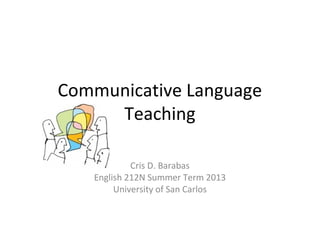
Communicative language teaching
- 1. Communicative Language Teaching Cris D. Barabas English 212N Summer Term 2013 University of San Carlos
- 2. Presentation Outline I. What is communicative language teaching? II. The nature of learners’ learning III. The background to CLT IV. Implications for methodology V. Classroom activities in CLT VI. CLT and cooperative learning VII.The push for authenticity VIII.Current trends in CLT
- 3. Tracing back… • Concurrent developments in Europe & North America • First proposed in the 1970s? • British linguist (1960s?): Communicative Approach aims to make communicative competence (Hymes, 1972) • Council of Europe: notional-functional concepts of language use syllabus
- 4. A methodology of choice? WHY? •Does it mean teaching conversation? •An absence of grammar in a course? •An emphasis on open-ended discussion activities?
- 5. The goals of language teaching •Communicative competence vs. grammatical competence
- 6. Communicative competence is what a speaker needs to know in order to be communicatively competent in a speech community.
- 7. Four dimensions of communicative competence (Canale and Swain, 1998) • Grammatical competence • Sociolinguistic competence • Discourse competence • Strategic competence
- 8. How is communicative competence viewed? • Knowing how to use language for a range of different purposes and functions • Knowing how to vary our use of language according to the setting and the participants (formal vs. informal speech, when to use language appropriately for written as opposed to spoken communication)
- 9. How is communicative competence viewed? • Knowing how to produce and understand different types of texts (narratives, reports, interviews, conversations) • Knowing how to maintain communication despite having limitations in one’s language (through using different kinds of communication strategies)
- 10. How learners learn a language? CLT as partly a response to the changes of understanding the processes of second language learning in the past 30 years
- 11. Before… • Mastery of grammatical competence • Language learning as a process of mechanical habit formation • Good habits are formed by having students produce correct sentences and not through making mistakes
- 12. Before… • Errors were to be avoided through controlled opportunities for production (either written or spoken) • Memorizing dialogs and performing drills, the chances of making mistakes were minimized • Teacher-controlled learning
- 13. CLT Innovation/Change in perspective • Interaction between the learner and users of the language • Collaborative creation of meaning • Creating meaningful and purposeful interaction through language • Negotiation of meaning as the learner and his or her interlocutor arrive at understanding
- 14. CLT Innovation/Change in perspective • Learning through attending to the feedback learners get when they use the language • Paying attention to the language one hears (the input) and trying to incorporate new forms into one’s developing communicative competence • Trying out and experimenting with different ways of saying things
- 15. The background to CLT With respect to the groupings of the language teaching trends in the last 50 years: Phase 1: traditional approaches (late 1960s) Phase 2: classic CLT (1970s-1990s) Phase 3: current CLT (late 1990s-present)
- 16. Phase 2: classic CLT (1970s-1990s) • the shifting of attention to the knowledge and skills needed to use grammar • the communicative competence • developed within the sub-discipline of sociolinguistics
- 17. What would a syllabus that reflected the notion of communicative competence look like and what implications would it have for language teaching methodology?
- 18. CLT (1970s and 1980s) • Purposes • Setting • Socially defined role • Communicative events • Language functions
- 19. CLT (1970s and 1980s) • Notions • Discourse/rhetorical skills • Variety • Grammatical content • Lexical content
- 20. • Communicative Syllabus (skill-based & functional) • English for Specific Purposes
- 21. Implications for Methodology • Make real communication the focus of language learning • Provide opportunities for learners to experiment and try out what they know • Be tolerant of learners’ errors as they indicate that the learner is building up of his or her communicative competence
- 22. Implications for Methodology • Provide opportunities for learners to develop both accuracy and fluency • Link the different skills such as speaking, reading, and listening together, since they usually occur so in the real world • Let students induce or discover grammar rules
- 23. Classroom activities in CLT Activities Focusing on Accuracy Activities Focusing on Fluency Reflect classroom use of language Reflect natural use of language Focus on the formation of correct examples of language Focus on achieving communication Practice language out of context Require meaningful use of language Practice small samples of language Require the use of communication strategies Do not require meaningful communication Produce language that may not be predictable Control choice of language Seek to link language use to context
- 24. Classroom activities in CLT II. Mechanical, Meaningful, and Communicative Practice III. Information-Gap Activities IV. Jigsaw Activities V. Task-completion: puzzles, games, map-reading VI. Information-gathering VII. Opinion-sharing VIII. Information-transfer IX. Reasoning-gap X. Role-plays
- 25. The emphasis on cooperative learning • Learn from hearing the language used by other members • Produce a greater amount of language than they would use in teacher-fronted activities • Likely to increase in motivational level • Bigger chance to develop fluency
- 26. The push for authenticity • Language classroom=preparation for survival in the real world “Classroom activities should parallel the ‘real world’ as closely as possible. Since language is a tool of communication, methods and materials should concentrate on the message and not the medium. The purpose of reading should be the same in class as they are in real life.” -Clarke and Silberstein (1977)
- 27. Changes in approaches to language teaching (Jacobs and Farrel, n.d.) 1. Learner autonomy 2. The social nature of learning 3. Curricular integration 4. Focus on meaning 5. Diversity 6. Thinking skills 7. Alternative assessment 8. Teachers as co-learners
